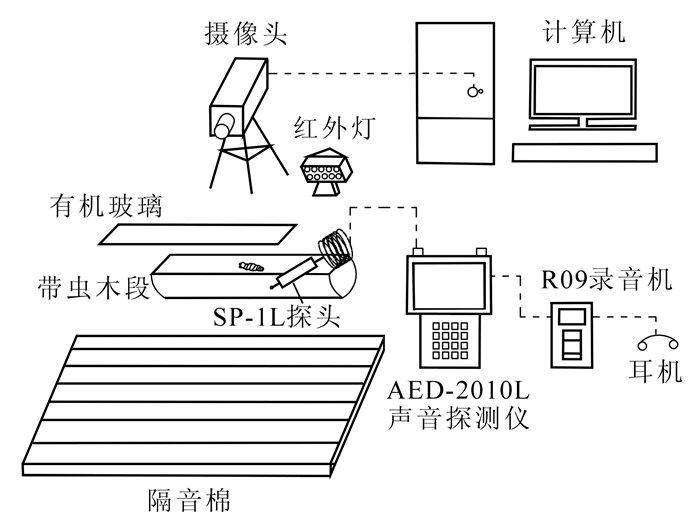-
声音侦听技术具有早期监测、准确率高、破坏性小等特点,在滞后性强、毁灭性大的隐蔽性害虫监测领域具有较为明显的应用前景[1]。科研工作者利用声音侦听技术,对水果害虫[2]、仓储害虫[3]、地下害虫[4]、林木蛀干害虫[5]等各类隐蔽性害虫开展了广泛的研究,为探测害虫活动的位置、强度及数量等提供了有效的技术支持,为有针对性防治害虫提供良好的数据支撑。目前,声音侦听技术的研究主要集中在开发研究设备[6]、扩展研究对象[7]、改进分析方法[8]等方面,也涉及了一些与隐蔽性害虫声行为相关的报道。程惊秋[9]对寄主木段中的桔梗天牛Nadezhdiella cantori幼虫、桑粒肩天牛Apriona qermari幼虫的声行为进行了研究。孙开源等[10]利用带有摄像装置的害虫声音采集平台,使用大震膜电容麦克风在隔音箱内对黄粉虫Tenebrio molitor成虫的爬行和咬食活动的声音进行了提取。KOČÁREK[11]研究发现了地中海天牛Icosium tomentosum幼虫独特的齐鸣行为。韦雪青[12]的研究表明,天牛幼虫爬行声信号具有不稳定性,时域规律不明显,频率范围较窄,主频小于取食声信号。王鸿斌等[13]对雌雄红脂大小蠹Dendroctonus valens成虫的多类声行为进行了声音特征分析,并用扫描电镜对其摩擦发声器官进行了观察与记录。潘杰等[14]利用声音探测技术对口岸经常截获的有害生物的取食和爬行声信号进行了探讨分析。隐蔽性害虫的声行为具有多样性,对应产生的信号也具有其本身的特征和差异。为了进一步明确和细化害虫不同类声行为的特征,排除各类声行为混合叠加影响侦听效果,提高侦听技术的实用性和准确性,本研究选取了林木蛀干害虫中常见的光肩星天牛Anoplophora glabripennis幼虫和星天牛A. chinensis幼虫,对其声行为进行了观察和分类,并对声信号进行了采集和分析。
-
供试的光肩星天牛、星天牛均采自浙江省宁波市杭州湾新区沿海防护林(30°10′N,121°14′E,平均海拔2.2 m)中的柳树Salix babylonica。该地的柳树虫口密度较大[15],便于采集和挑选。幼虫由北京林业大学林木有害生物防治北京市重点实验室鉴定。带虫木段的制备:沿蛀道剖开有虫木段,选取体型和活性等生理条件一致,龄期为3龄的2种幼虫各8头,龄期的划分参考贺萍等[16]和张海滨等[17]的方法。确认虫体活性后放回原蛀道,并将木段带有蛀道的剖面磨平,表面覆盖有机玻璃并用钢丝固定,放置昆虫1头·木段-1,2端蜡封保湿,在设定温度为20 ℃的生化培养箱内进行密闭饲养,每天检查昆虫的活性,待发现连续3 d有新鲜虫粪产生,说明昆虫已定居并开始蛀食,清理虫粪进行观察并采集声音。
-
声音侦听系统包括采集系统和分析系统。采集系统:AED-2010L便携式声音探测仪套机,含AED-2010主机,SP-1L低频传感探棒(共振晶体频率40 kHz,前置放大器40 db,输出50 Ω),DMH-30磁性转换接头,直径为1/16英寸钻头及适配器,SONY立体声耳机,电源适配器,USB数据线等;Roland R09高保真数字录音机。分析系统:Adobe Audition 3.0和Matlab平台下的林木蛀干害虫声音分析系统等。
其他配套硬件和软件:计算机(型号ASUS A42J);生化培养箱(LRH-250A);隔音棉(50 cm × 50 cm × 5 cm);IKENO IK-204摄像头;外置红外辅助灯;三脚架等。数据统计分析软件:Office Excel 2010和PASW Statistics 18等。
-
试验装置见图 1。在黑暗条件下,采取红外灯补光、摄像头连接计算机的方法。在计算机上用监控软件实时监视天牛幼虫在蛀道的行为并记录时间,同时利用声音侦听系统采集声音。
本试验预先在带虫木段距离幼虫3 cm处钻孔,用于放置和固定SP-1L探头。将木段放置于隔音棉上,AED-2010L便携式声音探测仪一端连接的SP-1L探头,另一端连接录音机R09用于采集声音数据,R09外接SONY耳机进行实时侦听。其中,AED-2010L选择H/C模式,时间设置为0 s,信号增益设置为G4级;R09选择采样率为44.10 kHz,位深为24 bits,保存格式为wav。2种天牛幼虫各8头,重复3次·头-1,2种幼虫各24段录音,每段录音时长10 min。
-
利用Adobe Audition 3.0对采集到的音频数据进行预处理和定性分析:首先通过采集预制噪音的模块逐次消除对试验结果影响最大的电噪声,然后对照时间轴分别挑选出4类声行为的声音脉冲信号片段,将其裁剪并保存,最后观察声信号的时域图、频谱图,并分析图形特征。
-
利用在Matlab平台自主编制的林木蛀干害虫声音分析系统对预处理后的声音信号片段中的单脉冲进行定量分析。该系统可以完成对声信号的图形输出和定量分析。本次试验在每段录音中的4类声行为各选取3个声脉冲,2种幼虫的每类声行为均计72个声脉冲,主要选取脉冲持续时间和主频2个数值进行统计分析,以此分别来反映信号的时域的频域两方面的特征。
-
根据观察,2种天牛幼虫的声行为主要都可以分为4类,取食声:幼虫咬噬寄主、取食时发声;爬行声:幼虫在蛀道中缓慢爬行,体表步泡突与寄主摩擦发声;清理蛀道声:幼虫依靠口器和虫体的挪动慢慢推动虫粪和木屑发声;自卫声:幼虫受惊时蜷缩虫体或快速爬行(向前或向后)发声。此外,还有难以归为上述4类的其他发声行为,如虫体活动时与寄主之间发生的一些无规律的摩擦和冲撞。
各类声行为观察的统计(表 1)表明:在4类声行为中,2种天牛幼虫的取食声时长均占比最高,分别为34.45%和34.14%,原因可能是供试幼虫处在合适的环境温度和取食量较大的龄期。爬行声时长仅次于取食声,2种幼虫占比都超过了25%;清理蛀道声占比约11%;自卫声占比最小,但也超过了5%。
表 1 天牛幼虫的声行为时长统计表
Table 1. Duration-statistical table about acoustic behaviors of cerambycid larvae
虫种 声行为计时/s 取食声 爬行声 清理蛀道声 自卫声 其他 总计 光肩星天牛 206.73±4.25 a 155.10±3.42 b 70.21±1.97 c 34.93±1.52d 25.61±1.01 d 492.58±5.70 星天牛 204.85±3.69 a 158.38±2.21 b 65.06±0.82 c 34.70±0.91 d 32.04±0.61 d 495.03±4.55 说明:表中数值为平均值±标准误差。同行中相同字母表示差异不显著,不同字母表示差异显著(P < 0.05)。 对比实时的侦听与监控,天牛幼虫的自卫声一般出现在录音的开始阶段,原因可能是侦听开始时,微小振动、木段位移等因素使幼虫感受了环境的变化,从而作出了应激反应。清理蛀道声一般出现在取食声和爬行声之间,幼虫通常将一段时间内取食产生的木屑和粪便进行清理,之后在蛀道内进行活动。
-
2种天牛幼虫的同类声行为波形相似,均包含一些共同的特征。取食声波前大后小,波形前端出现最大振幅后迅速趋于平稳,持续时间短,最大的相对振幅可达0.8,显著大于其他4类声行为;爬行声持续时间较长且不规律,振幅有波动但相对振幅一般不超过0.2,在4类声行为中是最小的;清理蛀道声会出现1个较大的振幅,相对振幅值可达0.5~0.6,仅次于取食声;自卫声波形间隔时间极短,一般小于50.0 ms,连续出现,振幅大于爬行声,相对振幅可达0.4(图 2)。
-
天牛幼虫的4类声行为的能量分布和频带各有差异,但频率的能量分布都是从低频段向高频段递减(图 3)。取食声能量分布集中,呈现的是1条小于50 ms的宽带谱线,由多个频率迭加而成,频率范围大,在0.0~20.0 kHz均有分布;爬行声能量分布较为分散,频带呈长条的窄带谱线,频率范围小:光肩星天牛幼虫分布在2.0~8.0 kHz,而星天牛则在1.0~6.0 kHz;清理蛀道声能量分布集中,频带窄但频率范围小:光肩星天牛幼虫分布在1.0~4.0 kHz,星天牛幼虫则在0.0~6.0 kHz;自卫声能量分布分散,条状谱带间隔出现,频率范围小,均在0.0~8.0 kHz。
-
2种天牛幼虫声行为的单脉冲持续时间和主频的均值统计结果见表 2。爬行声的脉冲持续时间最长,光肩星天牛为79.30 ms,星天牛为81.59 ms。清理蛀道声的脉冲持续时间居中,取食声和自卫声的脉冲持续时间最短,且两者较为接近。2种幼虫的同类声行为的频率接近,且取食声均显著大于其他声行为,自卫声次之,清理蛀道声再次之,爬行声最小。
表 2 天牛幼虫的声行为信号单脉冲的特征值
Table 2. The characteristic values about acoustic behaviors of cerambycid larvae
虫种 指标 取食声 爬行声 清理蛀道声 自卫声 光肩星天牛 单脉冲持续时间/ms 25.96±0.30 c 79.30±4.00 a 53.63±0.30 b 23.03±0.21 c 单脉冲主频/kHz 7.40±0.02 a 3.22±0.01 d 3.78±0.04 c 5.35±0.02 b 星天牛 单脉冲持续时间/ms 24.28±0.15 c 81.59±2.85 a 56.11±0.47 b 24.20±0.23 c 单脉冲主频/kHz 7.28±0.01 a 3.19±0.02 d 4.28±0.04 c 5.44±0.02 b 说明:表中数值为平均值±标准误差。同行中相同字母表示差异不显著,不同字母表示差异显著(P < 0.05)。 -
目前,科研工作者对隐蔽性害虫声行为的研究有限,在已有的研究中主要将声行为分为取食和爬行2类,而实际上,害虫的声行为具有多样性和复杂性。本试验将2种天牛幼虫的声行为主要分为4类,其中清理蛀道声和自卫声在绝大多数天牛幼虫中是普遍存在的。4类声行为的活动形式和发声原理存在差异,因此,产生的声音也具有不同的信号特征。取食声持续时间短、能量集中和频率高的特点可能是由于幼虫口器咬噬坚韧木纤维瞬间发出的声音的缘故;爬行声连续出现的原因是虫体移行时与蛀道持续摩擦,信号不稳定则可能由活动速率、活动方式和步泡突结构的差异导致的;清理蛀道声的时域波形图一般会出现一个较大的波峰,可能是因为幼虫用口器或躯体瞬时发力将虫粪和木屑推出蛀道形成较大能量;幼虫自卫时蜷缩虫体以假死或者以快速爬行的活动方式逃逸,从而导致自卫声和爬行声一样连续出现并具有更高的能量强度。探索天牛幼虫不同声行为的发声机制和影响因素,区别这些声音信号的特征,可以排除在实际侦听时各类声行为互相叠加带来的干扰,提高侦听效率和准确率。此外,这对于天牛幼虫的分类学和行为学的研究也具有一定的参考意义。
天牛幼虫的取食声由于具有持续时间短、振幅大和频率高的特征,并在侦听过程中表现为短促尖锐的听觉感受,因此,可以快速与环境噪音和其他发声行为进行辨别。在实际应用侦听技术监测天牛虫害时,工作人员可以通过选择幼虫取食频率较大的时段来提高侦听的效率。同时,结合国内和国外已有的研究,不同种害虫的取食声具有比较明显的时频差异,也可以利用它进行害虫的种间识别。
为了模拟天牛幼虫在蛀道中的黑暗环境,本试验监控时用来补光的红外灯、剖开的木段以及覆盖的有机玻璃都可能会对幼虫的生活产生一定的影响。本试验的环境和对象也均趋于理想,而在实际应用中,天牛幼虫会出现龄期不齐、个体差异、寄主不同等各种复杂情况,这就需要研究者控制不同变量,对幼虫在不同条件下的声音进行采集和补充,从而提高侦听技术的实用性和准确性。
本试验选取了2种同属的天牛幼虫。根据观察和统计,它们的同种声行为时间占比相近,信号特征相近,并无显著差异。其他隐蔽性害虫如重要的林木蛀干害虫小蠹类,幼虫及其雌雄成虫均可在寄主中危害,它们在蛀道中的声行为更趋于复杂且较难观察。各种害虫的不同类声行为,以及各类声行为的影响因素如口器结构、步泡突结构、活动速率等,值得进一步的研究和讨论。细化声行为的信号的共性和差异,探索具有应用价值的信号特征,并建立和补充害虫声音数据库,对进一步推动声学与昆虫学交叉领域的害虫声音侦听技术具有十分重要的意义。
Acoustic behaviors for two species of cerambycid larvae
-
摘要: 应用声音侦听技术监测隐蔽性害虫是一种较有前景的方法,明确害虫各类声行为的特征有利于排除不同声行为混合叠加的干扰,从而有效地识别害虫种类及其活动方式。利用红外监控下的声音侦听系统对光肩星天牛Anoplophora glabripennis幼虫和星天牛A. chinensis幼虫的声行为进行了分类和分析。2种天牛幼虫的声行为主要分为取食、爬行、清理蛀道和自卫4类,取食声占比最高,可达34%。4类声行为在时域图的最大振幅、波形和脉冲持续时间以及频谱图的能量分布和频段均表现出了不同的特征。此外,对声行为进行时域和频域的定量分析发现,脉冲持续时间和脉冲主频均体现出较大差异,取食声脉冲持续时间短,分别为25.96 ms和24.28 ms,主频最高,超过7.00 kHz。对天牛幼虫不同声行为的信号特征进行了探索,尝试通过排除各类声行为的干扰以提高侦听效果,同时发现取食声脉冲时间短、振幅大且频率高,在实际侦听时可以进行较快的辨别。Abstract: Acoustic detection technology is a promising method to monitor hidden pests. Defining characteristics about different acoustic behaviors of pests is beneficial to improve the accuracy of acoustic detection technology, can eliminate interference between different acoustic behaviors to help identify species and pest activities. This study explored and analyzed acoustic behaviors for different cerambycid larvae of Anoplophora glabripennis and Anoplophora chinensis by using an infrared monitoring and acoustic detection system. Results showed four types of acoustic behaviors:feeding, moving, cleaning, and self-protection, with feeding sounds having the largest proportion (34%). Time-domain graphs revealed differences with maximum amplitude, waveform, and pulse duration. Energy distribution and frequency band in spectrograms also showed differences. Single sound pulse duration and dominant frequency of acoustic behaviors had different characteristic values. Pulse duration of the feeding sound was short (25.96 ms for A. glabripennis and 24.28 ms for A. chinensis). The highest dominant frequency was with the feeding sound (exceeding 7.00 kHz). This study produced helpful information regarding elimination of noise and showed that in practical application the feeding sound could be easily identified with short pulse duration, large amplitude, and high frequency.
-
表 1 天牛幼虫的声行为时长统计表
Table 1. Duration-statistical table about acoustic behaviors of cerambycid larvae
虫种 声行为计时/s 取食声 爬行声 清理蛀道声 自卫声 其他 总计 光肩星天牛 206.73±4.25 a 155.10±3.42 b 70.21±1.97 c 34.93±1.52d 25.61±1.01 d 492.58±5.70 星天牛 204.85±3.69 a 158.38±2.21 b 65.06±0.82 c 34.70±0.91 d 32.04±0.61 d 495.03±4.55 说明:表中数值为平均值±标准误差。同行中相同字母表示差异不显著,不同字母表示差异显著(P < 0.05)。 表 2 天牛幼虫的声行为信号单脉冲的特征值
Table 2. The characteristic values about acoustic behaviors of cerambycid larvae
虫种 指标 取食声 爬行声 清理蛀道声 自卫声 光肩星天牛 单脉冲持续时间/ms 25.96±0.30 c 79.30±4.00 a 53.63±0.30 b 23.03±0.21 c 单脉冲主频/kHz 7.40±0.02 a 3.22±0.01 d 3.78±0.04 c 5.35±0.02 b 星天牛 单脉冲持续时间/ms 24.28±0.15 c 81.59±2.85 a 56.11±0.47 b 24.20±0.23 c 单脉冲主频/kHz 7.28±0.01 a 3.19±0.02 d 4.28±0.04 c 5.44±0.02 b 说明:表中数值为平均值±标准误差。同行中相同字母表示差异不显著,不同字母表示差异显著(P < 0.05)。 -
[1] 赵源吉.双条杉天牛幼虫声信号监测技术研究[D].北京:北京林业大学, 2009. ZHAO Yuanji. Preliminary Study on the Acoustic Detection of Larvae Semanotus bifasciatus (Motschulsky)[D]. Beijing:Beijing Forestry University, 2009. [2] WEBB J C, LANDOLT P J. Detecting insect larvae in fruit by vibrations produced[J]. J Environ Sci Health Part A Environ Sci Eng, 1984, 19(3):367-375. [3] HAGSTRUM D W, VICK K W, WEBB J C. Acoustical monitoring of Rhyzopertha dominica (Coleoptera:Bostrichidae) populations in stored wheat[J]. J Econ Entomol, 1990, 83(2):625-628. [4] MANKIN R W, LAPOINTE S L, FRANQUI R A. Acoustic surveying of subterranean insect populations in citrus groves[J]. J Econ Entomol, 2001, 94(4):853-859. [5] MANKIN R W, SMITH M T, TROPP J M, et al. Detection of Anoplophora glabripennis (Coleoptera:cerambycidae) larvae in different host trees and tissues by automated analyses of sound-impulse frequency and temporal patterns[J]. J Econ Entomol, 2008, 101(3):838-849. [6] 姚青.多功能昆虫鸣声信号采集与分析系统及其在褐飞虱声通讯研究中的应用[D].北京:中国农业科学院, 2003 YAO Qing. Data Acquisition and Analysis System of Insect Acoustic Signal and Its Application in Signal Study of Nilaparvata lugens (Stal)[D]. Beijing:Chinese Academy of Agricultural Sciences, 2003. [7] 赵丽稳, 王鸿斌, 张真, 等.昆虫声音信号和应用研究进展[J].植物保护, 2008, 34(4):5-12. ZHAO Liwen, WANG Hongbin, ZHANG Zhen, et al. Research advances in insect acoustic signals and their applications[J]. Plant Prot, 2008, 34(4):5-12. [8] 耿森林, 尚志远.仓储粮食中害虫活动声的提取与频谱分析[J].西南师范大学学报(自然科学版), 2005, 30(6):1057-1060. GENG Senlin, SHANG Zhiyuan. The sampling of the insect ativity sound in the storage grain and its frequency spectrum analysis[J]. J Southwest China Norm Univ Nat Sci, 2005, 30(6):1057-1060. [9] 程惊秋.桔褐天牛和桑粒肩天牛幼虫声行为的研究[J].林业科学, 1993, 29(4):307-312. CHENG Jingqiu. A study on the acoustic behavior of larvae in the longhorned beetle, Nadezhdiella cantori (Hope), and Apriona qermari (Hope)(Coleoptera:Cerambycidae)[J]. Sci Silv Sin, 1993, 29(4):307-321. [10] 孙开源, 曹阳, 李燕羽, 等.黄粉虫成虫爬行和咬食活动声音采集分析研究[J].河南工业大学学报(自然科学版), 2008, 29(6):39-44. SUN Kaiyuan, CAO Yang, LI Yanyu, et al. Acoustic detection of walking and feeding activities of Tenebriomolitor linnaeus adult[J]. J Henan Univ Technol Nat Sci Ed, 2008, 29(6):39-44. [11] KOÁREK P. Sound production and chorusing behaviour in larvae of Icosium tomentosum[J]. Cent Europ J Biol, 2009, 4(3):423-426. [12] 韦雪青.林木蛀干害虫声音监测技术初探[D].北京:北京林业大学, 2010. WEI Xueqing. Primary Study on Sound Monitoring Technology of Wood Boring Insects[D]. Beijing:Beijing Forestry University, 2010. [13] 王鸿斌, 赵丽稳, 罗茜, 等.红脂大小蠹声音信号记录、分析与发声器官电镜观察[J].林业科学研究, 2012, 25(1):17-22. WANG Hongbin, ZHAO Liwen, LUO Qian, et al. Acoustic signals of Dendroctonus valens and structure of its stridulatory apparatus[J]. For Res, 2012, 25(1):17-22. [14] 潘杰, 刘翔, 邵沛泽, 等.缝锤小蠹与美西部云杉小蠹的声学特征与比较[J].环境昆虫学报, 2014, 36(3):395-401. PAN Jie, LIU Xiang, SHAO Peize, et al. Acoustic characteristics and their comparison of Gnathotrichus materiariusand Gnathotrichus sulcatus[J]. J Environ Entomol, 2014, 36(3):395-401. [15] 刘佳敏, 徐华潮.苦楝对星天牛的引诱研究[J].浙江农林大学学报, 2014, 31(3):437-441. LIU Jiamin, XU Huachao. Attractiveness of Melia azedarach to Anoplophora chinensis[J]. J Zhejiang Univ A & F Univ, 2014, 31(3):395-401. [16] 贺萍, 黄竞芳.光肩星天牛的人工饲养[J].北京林业大学学报, 1992, 14(2):61-67. HE Ping, HUANG Jingfang. Laboratory rearing of Anoplophora glabripennis[J]. J Beijing For Univ, 1992, 14(2):61-67. [17] 张海滨, 王建伟, 朱小峰, 等.星天牛幼虫龄期的划分[J].应用昆虫学报, 2011, 48(3):688-694. ZHANG Haibin, WANG Jianwei, ZHU Xiaofeng, et al. Determination of larval instars of citrus long-horned beetle, Anoplophora chinensis (Coleoptera:Cerambycidae)[J]. Chin J Appl Entomol, 2011, 48(3):688-694. -

-
链接本文:
https://zlxb.zafu.edu.cn/article/doi/10.11833/j.issn.2095-0756.2017.01.008







 下载:
下载:




